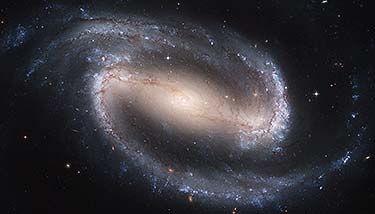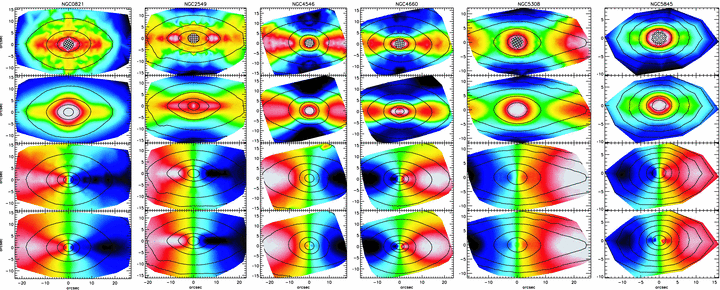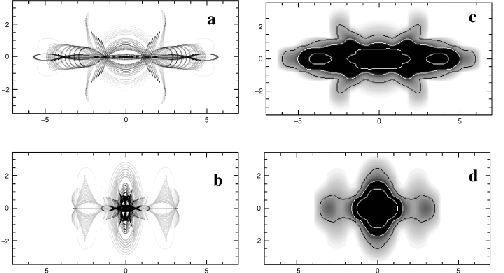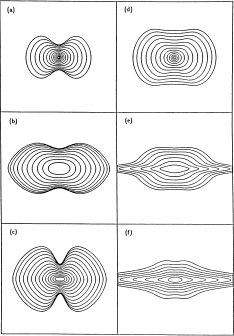
HST/ACS image of the barred spiral galaxy NGC1300,
nicely illustrating bar-driven gaseous inflow and star formation.

Below are descriptions of the MPhys projects I currently have on offer. All deal with galaxy formation and evolution, primarily through detailed studies of nearby objects, and they include both observational and theoretical projects. Understanding how galaxies form and evolve is central to modern astrophysics, and those projects each contribute in their own way to this larger enterprise.
The projects are meant to last the equivalent of 4 weeks full-time, but spread over an approximately 8 weeks periods, with some preparatory reading beforehand. This is short, so a full commitment is necessary to achieve meaningful results. If you are interested by one of the projects and would like to discuss it further, please contact me as soon as possible.
Note also that even though many projects are on offer, I only intend to take 2 students.
A Universal Scaling Relation for Elliptical and Spiral Galaxies
Kinematic Signatures of Axisymmetric Boxy Bulges in Spiral Galaxies
Orbital Structure of Boxy Bulges in Spiral Galaxies
A Universal Scaling Relation for Elliptical and Spiral Galaxies
(with
Bureau and
Cappellari; observational)

Galaxies come in many different shapes and sizes. Indeed, elliptical (spheroidal) galaxies satisfy a classic scaling relation, the Fundamental Plane, relating the luminosity, size, and velocity dispersion of their stars. This is generally understood as due to the galaxies being supported against gravity by "pressure". Spiral (disk) galaxies however obey an apparently different scaling relation, the Tully-Fisher law, relating their rotation velocity and luminosity. This is because spirals are supported against gravity by rotation. Despite these apparent differences, recent work suggests that the two classic scaling relations are simply different views of the same phenomenon, and that the intrinsic structures of elliptical and spiral galaxie are in fact closely related. The goal of this project is to test this hypothesis. Using dynamical models to fit the stellar kinematics observed with the state-of-the-art SAURON integral-field spectrograph, the project aims to determine the rotation velocity of a sample of spiral galaxies. Comparing these to existing models of elliptical galaxies will allow to test the existence of a unique, universal scaling relation for both types of galaxies. Knowledge or a desire to learn basic skills of the IDL programming language is essential for this project.
Orbital Structure of Boxy Bulges in Spiral Galaxies
(with
Bureau; observational)

Spiral galaxies generally harbour nearly spherical central bulges, but some bulges appear boxy or peanut-shaped when viewed edge-on. This characteristic is generally attributed to the presence of a (non-axisymmetric) bar in their disks, and the peculiar orbital structure associated with it. Using images from the Hubble Space Telescope (HST) and simple image enhancement algorithms, this project aims to probe the substructure of boxy bulges and compare this with predictions from detailed orbital calculations in the literature. Are boxy bulges really due to bars?
Kinematic Signatures of Axisymmetric Boxy Bulges in Spiral Galaxies
(with
Bureau and Binney; theoretical/numerical)

Many spiral galaxies harbour bulges that are boxy-shaped rather than spheroidal. Those are generally thought to be bars viewed edge-on, but there exists a class of axisymmetric (i.e. round) models with similar properties but presumably wholly different origins. As the stellar kinematics of both types of models should be very different, this project aims to identify and study characteristic kinematic signatures of axisymmetric models which are accessible observationally. Those will be obtained by first solving numerically Poisson's equation for a family of bulge models (distribution functions) and second deriving and comparing their observed properties with published bar models and observations. A code solving Poisson's equation already exists, but it will need to be augmented to derive and fit the observed kinematics with familiar functions used by observers. Familiarity with numerical methods and good computer coding skills are thus essential for this project.
To go back to my Home Page, click here:
![]()
This page was last modified on 9 October 2009